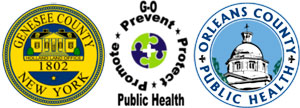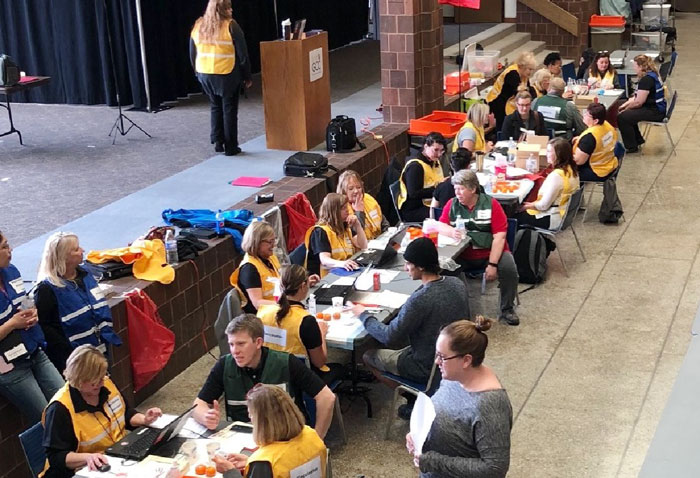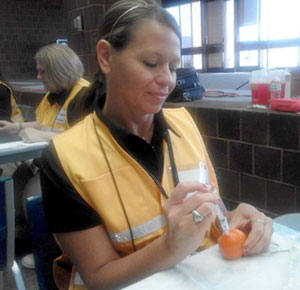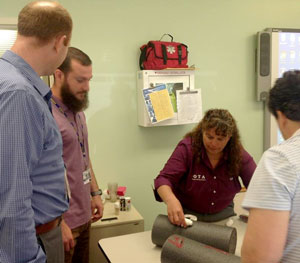Genesee and Orleans County Cross Jurisdictional Sharing Project (GO Health)
- Need: Two rural upstate New York counties struggled to provide necessary public health leadership and services amid a fluid environment with rising costs and funding limitations.
- Intervention: The Genesee County and Orleans County health departments began a cross jurisdictional sharing relationship that integrated select functions and services, beginning with sharing a director and deputy director.
- Results: By sharing personnel and functions, management personnel costs have been cut in half and both counties have saved over $2 million for the counties combined.
Description
 The state of New York passed legislation in 2011
that allows up to 3 county public health offices in
counties with a combined population of less than 150,000
to share staff and services under the management of one
public health director. Genesee County and
Orleans County, two
rural counties in western New York, were struggling to
provide mandated public health services while facing
budget restraints. In 2012, they entered a 2-year pilot
project to study the feasibility of combining some of
their public health functions in order to save money and
work more collaboratively.
The state of New York passed legislation in 2011
that allows up to 3 county public health offices in
counties with a combined population of less than 150,000
to share staff and services under the management of one
public health director. Genesee County and
Orleans County, two
rural counties in western New York, were struggling to
provide mandated public health services while facing
budget restraints. In 2012, they entered a 2-year pilot
project to study the feasibility of combining some of
their public health functions in order to save money and
work more collaboratively.
The aim of their Genesee and Orleans County Cross Jurisdictional Sharing Project (GO Health) is to work collaboratively while maintaining two distinctive health departments with shared leadership and integrated service delivery. Both departments are governed by their respective legislatures and boards of health. Under the agreement, they share the following personnel:
- Public health director
- Environmental health director
- Community health services director
- Children with special needs director
- Weights and measures director
- Director of health promotion
- Epidemiology coordinator
- Service coordinator
- Emergency preparedness coordinator
- Emergency preparedness educator
- Administrative and field staff as needed
Since 2015, the two counties have shared a commonly appointed Board of Health. The counties also contract together for medical and environmental engineering consulting, share an early childhood transportation provider, and share additional purchasing in some programs. GO Health has developed common policies and fee schedules for their community, environmental health programs, and a common sanitary code for both counties. They also complete a joint community health assessment and community health improvement plan (CHA/CHIP) with Wyoming County that represents Genesee, Orleans and Wyoming (GOW) Counties.
GO Health had help on the cross jurisdictional sharing (CJS) project by utilizing the Lake Plains Community Care Network (LPCCN) as a neutral and non-governmental facilitation resource, and University at Buffalo's School of Public Health and Health Professions (UBSPHHP) as a technical/policy advisor.
GO Health is one of 16 public health partnerships across the country to implement a CJS program model using a grant from the Center for Sharing Public Health Services (CSPHS), a national initiative managed by the Kansas Health Institute with support from the Robert Wood Johnson Foundation.

Services offered
By combining some resources, functions, and staff in their health departments, the two counties share services that enhance their role as public health facilitators and educators in their respective communities:
- Emergency preparedness
- Public health education and promotion
- Environmental engineering consulting
- Community messaging and public information
- Medical consulting
- Early childhood transportation
- Environmental health facility inspections
- Seasonal farm workers outreach program
- Immunization clinics (flu, COVID-19, etc.)
- Telehealth activities for Tuberculosis control
- Epidemiology
- Weights and measures
Results
As a result of this collaboration, the 2 counties have had a combined savings of over $2,177,000. In addition to cost savings, the arrangement has helped the counties identify and reduce duplications in tasks. Having completed 10 years of this arrangement in October of 2022, they have entered into a long-term intermunicipal agreement extending CJS sharing through 2026. Other results include:

- Genesee County now pays only half as much for its environmental health director (Orleans County previously had no environmental health director).
- Orleans County now pays less for medical, environmental engineering, and transportation consultants by joining Genesee County's contract for these services.
- Savings have been achieved through process and policy improvements, such as developing common policies and fee schedules for septic inspections that allow sharing sanitarians in both counties.
- Additional savings have resulted from reduced staff time costs when one staffer represents both health departments at local, regional, or state meetings.
- Administrative efficiency has increased: staff meetings have been reduced to once a month, communication is more streamlined, and goals more easily met.
- Sharing staff and resources has aligned policies, procedures, and the 2 public health office cultures. GO Health has shared competencies and expertise across the 2 counties.
- GO Health has become the single point of contact for the 2 counties' healthcare providers and health systems.
- Received approval for a public health associate from the Center for Disease Control to participate in the program's operations for 2 years. A joint county application gave GO Health an advantage to being chosen as a host site to 4 fellows to date.
- The GO Health director and deputy director participated in the Kresge Foundation Emerging Leaders in Public Health fellowship, a national program that is looking at role transformation with a focus on cross jurisdictional telehealth to improve access to care.
- GO Health is an active member of the Genesee–Orleans-Wyoming Opioid Task Force. This task force works collaboratively to prevent and reduce overdose deaths throughout the GOW region.
- In 2022, GO Health developed their own lab and started wastewater analysis. They are currently the only two counties in New York State that are doing wastewater analysis independently. Presently, they are testing for SARS-CoV-2, Influenza A and B, RSV and various opioid analogues.
- GO Health submitted for public health accreditation in January 2023 through Public Health Accreditation Board (PHAB). This process is expected to be completed during the fourth quarter of 2023.
- In 2023, GO Health added two shared positions (Director of Health Promotion and an Epidemiology Coordinator) to help align health education and epidemiology across the two counties.
- As a result of funding from the Department of Housing and Urban Development (HUD) and the Centers for Disease Control and Prevention (CDC), GO Health has expanded their lead poisoning prevention program to Livingston and Wyoming Counties to address lead hazards and prevent childhood lead poisoning throughout the entire Genesee, Livingston, Orleans and Wyoming (GLOW) region.
For more information about the program:
- Bedard, B. A., Younge, M., Pettit, P., Mendoza, M. (2017). Using Telemedicine for Tuberculosis Care Management: a Three County Inter-Municipal Approach. 42(1), 12. Article Abstract.
- Orleans and Genesee are first in NY to merge Health Department boards, Orleans Hub, 2015.
Challenges
- When first combining public health units, anxiety levels were high among existing staffers who were concerned that their positions may be cut if tasks became shared and/or staff was integrated.
- Although the state of New York allows public health departments to combine services and share staff, legislation still limits how far integration can go. Managing 2 offices and 2 separate budgets has caused some problems and restricted potential efficiencies that could be realized with legislative changes.
- New York law requires each county's public health office to have their own board of health, but allows them to be commonly appointed to the same board from each county. GO Health created a common board that discusses matters of both offices at one meeting and takes action on behalf of both counties. A full merger of the boards would allow for further efficiencies.
- GO Health still lacks a synchronized information technology (IT) system. Because each county's IT department operated differently, it will take additional time and effort to get the two synced.
Replication

- Often, state funds administered to county services can vary year to year. Through a CJS relationship, public health units can leverage existing funds and cut down on costs while delivering the same quality services to communities.
- Take adequate time to educate your boards and legislators about the benefit of a CJS partnership. The GO Health director spent a year talking with board members and legislators and the state health department about the benefits of a model like this.
- Changing the culture by bringing 2 organizations and counties together takes a methodical and thoughtful approach, considering opportunities rather than forcing change. Make sure staff have meetings in person together and assign projects to staff from both offices, creating opportunity for trusting relationships to grow.
- An operation like this needs a strong buy-in from both public health offices and communities. If one is more committed than the other, the partnership will have a much more difficult time thriving. Before combining services, make sure commitment requirements and expectations are clearly outlined.
- Always look for new and innovative ways to deliver public health services, especially in rural areas. Prior to GO Health, Genesee and Orleans County had multiple other joint projects and a collaborative history, making the idea of a CJS partnership seem more manageable.
- A successful partnership like this takes a leader who has the interest of both public health offices and all staff at the forefront of decisions and changes as well as open communication with all staff, the board of health, legislators, and stakeholders.
- Combining services may free up funds to support additional services. Be open to including new services, for instance Office for the Aging, Youth Bureau, and Mental Health, that would improve access for rural residents.
CSPHS contains research on best practices, case studies, and toolkits for rural jurisdictions considering or in the process of adopting CJS.
GO Health is one of the only public health cross jurisdictional sharing projects in the state. The public health director regularly shares the model at state conferences and encourages other counties to consider implementing it.
Contact Information
Paul A. Pettit, MSL, Public Health DirectorGenesee & Orleans County Health Departments
585.344.2580 x 5555
Paul.Pettit@orleanscountyny.gov
Topics
Networking and collaboration
· Public health
States served
New York
Date added
December 21, 2017
Suggested citation: Rural Health Information Hub, 2023 . Genesee and Orleans County Cross Jurisdictional Sharing Project (GO Health) [online]. Rural Health Information Hub. Available at: https://www.ruralhealthinfo.org/project-examples/997 [Accessed 4 January 2026]
Please contact the models and innovations contact directly for the most complete and current information about this program. Summaries of models and innovations are provided by RHIhub for your convenience. The programs described are not endorsed by RHIhub or by the Federal Office of Rural Health Policy. Each rural community should consider whether a particular project or approach is a good match for their community’s needs and capacity. While it is sometimes possible to adapt program components to match your resources, keep in mind that changes to the program design may impact results.
